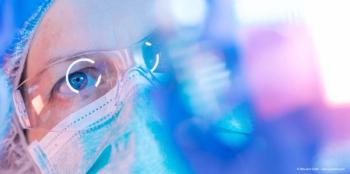
- Modern Retina Fall 2024
- Volume 4
- Issue 3
Digital Exclusive: An interview with David Eichenbaum, MD, on his ASRS 2024 presentation
David Eichenbaum, MD, spoke with Modern Retina to provide and overview on his presentation at ASRS 2024 and the current state of geographic atrophy treatment.
For years, geographic atrophy (GA) was a condition that had no approved treatments in the US or abroad. In 2023, there was a notable change: Not only 1, but 2 treatments for GA received FDA approval, opening the doors for retina specialists to begin offering treatment to patients with GA.
Now, in 2024, real-world data and continued monitoring of clinical trial participants is providing a robust understanding of the results of these treatments. This data featured heavily at the 2024 American Society of Retina Specialists (ASRS) meeting that was held over the summer in Stockholm, Sweden.
Among the presenters was David A. Eichenbaum, MD, FASRS, a partner and Director of Research at Retina Vitreous Associates of Florida. He gave a presentation at the conference highlighting the safety and efficacy of pegcetacoplan and the potential future of geographic atrophy treatments.
Modern Retina caught up with Dr Eichenbaum to discuss this presentation.
Note: This interview transcript has been lightly edited for clarity.
David Eichenbaum, MD: I'm excited to be part of this expert discussion on pegcetacoplan at the annual ASRS meeting in Stockholm, Sweden. We have a section dedicated to the most current data that we have on the pegcetacoplan extension trial, GALE. We have exciting functional vision data, both post-hoc analyses with are supportive, a pre-specified visual, functional endpoint of microperimetry, which Paul Hahn, MD, PhD, is going to present that all tell the story of better visual preservation for patients with geographic atrophy when they are exposed to pegcetacoplan monthly or every other month for 36 months. So, it's an exciting time as we learn more about the efficacy of the drug. And of course, this is a section entitled safety. So, presentations are balanced by real-world safety presentations from 2 fellows who represent large retina platforms with dozens of doctors and thousands of injections. And we'll put together a conversation about the efficacy of the data that we have from the randomized controlled trials and the extension and the real-world safety.
Sydney M. Crago: When we look at the data that we're going to be speaking on with this presentation, what were kind of the sources of that data? And how did you go about gathering that information?
DE: The sources for me and Paul [Hahn], what all I'll speak to, initially, are the GALE extension studies, which were, what the patients from OAKS and DERBY rolled into following completion of 24 months and the achievement of the endpoint of the parent study. Over 80% of the patients in OAKS and DERBY rolled into the GALE extension study, and over 90% of the patients who started and GALE completed that study. So that's the source of our clinical trial data. The source of the safety data, as far as I understand it, are the databases from these multi-location, multi-doctor, retina private equity-owned clinic sites. They're basically doctor's offices.
SMC: When you look at the comparison of the clinical trial data to the real-world data, were there any surprising deviations or anything that stood out?
DE: You know, not really. The drug is a very safe drug. Like any other intravitreal injection, there are risks to putting a drug into an eye, of putting needles into the body, especially if you do it at a relatively high frequency. And this particular product, for better or for worse, is given at a relatively high frequency to achieve efficacy. It's given every 1 to 2 months. So, there are risks to that, but the real-world datasets don't seem to show a change in the risk over time or an increase in risk where we've learned a lot about the safety profile of pegcetacoplan. The risk seems to be stable, which is good. We know what the risks are, and we're learning more about the efficacy and where it fits in from a beneficial standpoint.
SMC: Were there any intervention criteria in the GALE extension trial for any adverse events?
DE: So whenever there's an adverse event, it's treated at the discretion of the investigator. So, if there's inflammation, or if there's endopthalmitis, the investigator treats that with anti-inflammatories, if it's inflammation, treats it with antibiotic, if it's endopthalmitis. And whenever that occurs, whether it's in the parent study or the extension study, patients who have adverse events are treated, to give them the best possible outcome.
SMC: From your perspective, what would you say are the major takeaways from this data set?
DE: There's a compendium of evidence in post-hoc analyses, which speak to a functional visual benefit in patients who are exposed to pegcetacoplan. As you know, there's never been a visual acuity difference demonstrated prospectively in any of the phase 2 or phase 3 geographic atrophy programs for pegcetacoplan or avacincaptad pegol. However, if you look at the data and you do post-hoc analyses, you see a variety of analyses that speak to a functional benefit of treating geographic atrophy with these drugs. It's not as profound as we would like to see, but it's remarkable because just a year and a half ago, we had nothing commercially available with any benefit at all. My presentation highlights an analysis based on the World Health Organization (WHO) criteria for severe vision loss which is 20/200, or 35 letters, or less on the ETDRS eye chart. And what we show in this post-hoc analysis is that both [doses of] monthly and every other month pegcetacoplan have a clear reduction of the incidence of severe vision loss that persists over several months in patients with geographic atrophy. There wasn't a pre-specified prospective analysis, but the post-hoc analysis, which feeds into other post-hoc analyses that had been done using microperimetry, which has now also demonstrated prospectively as a pre-specified analysis, but post-hoc analyses of microperimetry, post-hoc analyses of severe vision loss, all speak to the compendium of evidence, that's building a case for efficacy with pegcetacoplan exposure and geographic atrophy over time. It takes time to see this difference, but by the time you get to 36 months, you see these differences in function.
SMC: As we have more time with the drug, both commercially and to follow the study participants, where do you see the future of this particular geographic atrophy treatment going?
DE: So what I'd like to see in the future is some of the clinical development programs we have, bearing fruit, especially with regards to either durability, because of giving these medications to patients every 1 to 2 months, and they all get worse, isn't something that patients adhere to very well, in the real world, or improved efficacy, There are programs looking at both complement inhibition and at different places and different mechanisms of action, which may yield better efficacy than what we see with pegcetacoplan or avacincaptad pegol. I'd like to see a sustained release formulation of either pegcetacoplan or avacincaptad pegol. These are drugs that we know work. Currently, they're given in solutions. It'd be interesting to see if an extended-release platform could be developed that utilizes these known quantities. There are a lot of things in the hopper, you know, and there's a phase 3 program starting [to] look at the look at complement inhibition in a different place, which has a basic science story of neuroprotection, basically, that may yield better visual acuity. There was a phase 2 study looking at gene therapy looking at complement inhibition. There's a phase 2 study looking at macrophage modulation. There's a lot of work to do better. We just don't know exactly if or which of those are going to succeed in late phase clinical development.
The safety profile of pegcetacoplan is fairly well-established. Now there have been over a quarter million doses given commercially and in clinical trials, probably by the time we get to ASRS it will be 300,000 doses given we have not seen a change in the in the risk of infrequent inflammatory vasculitis, which occurs at about a rate of 1 in 10,000 infections, or 1 in 4,000 new patients best as we can tell, but what we are learning is more about the efficacy profile. We're learning what dosing frequency works. We're learning where we want to start treating patients. We're learning which patients not to treat, perhaps which patients won't have a significant benefit in visual function. So, as we're seeing stability of the safety profile, we're learning more about the efficacy profile. So that's where we want to go with commercially available drugs and real-world data.
Articles in this issue
about 1 year ago
A great leap forward in ophthalmic drug delivery?about 1 year ago
The sights of Stockholmabout 1 year ago
Higher molar dose in the real world and clinical trialsabout 1 year ago
Spotlight on GA: Promoting early detection and treatmentabout 1 year ago
The unique role of the retina optometristabout 1 year ago
The future of retina careNewsletter
Keep your retina practice on the forefront—subscribe for expert analysis and emerging trends in retinal disease management.















































